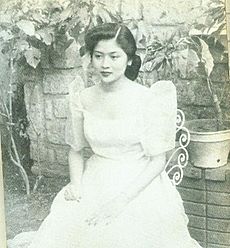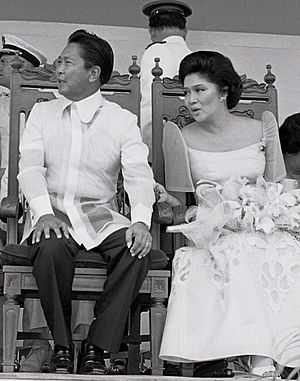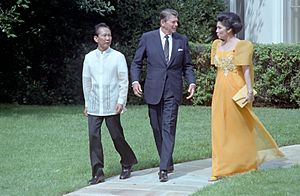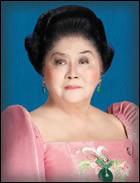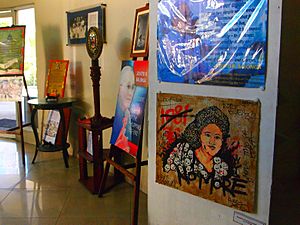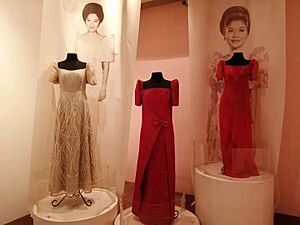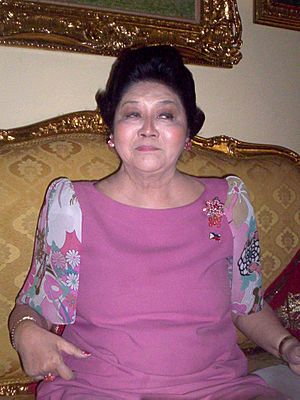Imelda Marcos facts for kids
Quick facts for kids
Imelda Marcos
|
|
|---|---|

Marcos in 1973
|
|
| Member of the Philippine House of Representatives | |
| In office June 30, 2010 – June 30, 2019 |
|
| Preceded by | Bongbong Marcos |
| Succeeded by | Eugenio Angelo Barba |
| Constituency | 2nd District of Ilocos Norte |
| In office June 30, 1995 – June 30, 1998 |
|
| Preceded by | Cirilo Roy Montejo |
| Succeeded by | Alfred Romualdez |
| Constituency | 1st District of Leyte |
| Member of Parliament for Region IV (Metro Manila) | |
| In office June 12, 1978 – June 5, 1984 |
|
| 1st Governor of Metro Manila | |
| In office February 27, 1975 – February 25, 1986 |
|
| Appointed by | Ferdinand Marcos |
| Vice Governor | Mel Mathay (1979–1986) |
| Preceded by | Office established |
| Succeeded by | Joey Lina (OIC) |
| Minister of Human Settlements | |
| In office June 12, 1978 – February 25, 1986 |
|
| President | Ferdinand Marcos |
| Preceded by | Office established |
| Succeeded by | Office abolished |
| First Lady of the Philippines | |
| In role December 30, 1965 – February 25, 1986 |
|
| President | Ferdinand Marcos |
| Preceded by | Eva Macapagal |
| Succeeded by | Amelita Ramos (1992) |
| Personal details | |
| Born |
Imelda Remedios Visitación Trinidad Romuáldez
July 2, 1929 San Miguel, Manila, Philippines |
| Political party | Nacionalista (1965–1978; 2009–present) |
| Other political affiliations |
Kilusang Bagong Lipunan (1978–2015) |
| Spouses | |
| Children | Imee Marcos Bongbong Marcos Irene Marcos Aimee Marcos (adopted) |
| Criminal status | Released on bail pending appeal |
| Conviction(s) | Found guilty of misusing public funds |
| Criminal penalty | Imprisonment and suspension from public office |
| Residences | Makati, Metro Manila |
Imelda Romualdez Marcos (born Imelda Remedios Visitación Trinidad Romuáldez; July 2, 1929) is a Filipino politician. She served as the First Lady of the Philippines from 1965 to 1986. During this time, her husband, Ferdinand Marcos, led the country. She became very powerful after he declared martial law in September 1972. She is also the mother of the current president, Bongbong Marcos.
During her husband's 21 years in power, Imelda Marcos oversaw the building of many large projects. These projects, often built very quickly, were part of what was called her "edifice complex". She and her husband were found to have improperly used billions of pesos from the Filipino people. By the time they were removed from power in 1986, their personal wealth was estimated to be between US$5 billion and US$10 billion. By 2018, the Philippine government had recovered about $3.6 billion of this money.
Imelda Marcos and her family became known for their very expensive lifestyle. This happened during a time when the country faced economic problems and public unrest. She often traveled abroad for state visits, fancy parties, and shopping trips. She spent a lot of public money on her personal collections of art, jewelry, and shoes. She famously owned 3,000 pairs of shoes. She was found guilty of misusing public funds in 2018 for her actions as governor of Metro Manila. This case is currently being appealed. She and her husband hold a Guinness World Record for the largest amount of money improperly taken from a government.
The People Power Revolution in February 1986 removed the Marcos family from power. They were forced to leave the Philippines and live in Hawaii. In 1991, President Corazon Aquino allowed the Marcos family to return. This was so they could face various charges after Ferdinand Marcos passed away in 1989. Imelda Marcos was elected four times to the House of Representatives of the Philippines. She also ran for president twice but did not win enough votes.
Contents
- Early Life and Family Background
- Education
- Early Career
- Courtship and Marriage
- 1965 Presidential Campaign
- First Term (1965–1969)
- Second Term (1969–1972)
- Martial Law Period (1972–1981)
- Downfall
- Exile in Hawaii (1986–1991)
- Return from Exile (1991–Present)
- Major Court Cases
- Personal Wealth
- Edifice Complex
- Cultural Influence
- Honors
- See also
Early Life and Family Background
Imelda Remedios Visitación Romuáldez was born in San Miguel, Manila, on July 2, 1929. Her parents were Vicente Orestes Romuáldez, a lawyer, and his second wife, Maria Remedios Trinidad. Imelda was the sixth of Vicente's eleven children and Remedios' firstborn. Her family, the Romualdez political dynasty, came from the province of Leyte. They were a wealthy family and devout Catholics.
Important members of Imelda's family include her uncle Norberto Romualdez, who was a Supreme Court Justice. Her younger brother, Benjamin "Kokoy" Romualdez, served as Governor of Leyte and later as an ambassador.
Around 1932, her family's financial situation became difficult. Imelda's parents separated for a time. Her mother, Remedios, worked for nuns. Vicente and Remedios later got back together, but Remedios and her children moved to their house's garage to avoid more arguments. Remedios passed away on April 7, 1938, from double pneumonia. In November 1938, Imelda's father left Manila and returned to Tacloban. There, he could support his family with a simpler life. Imelda grew up speaking the Waray language, then learned Tagalog and English.
Education
Elementary School Years
Imelda started first grade at College of the Holy Spirit Manila. Her older half-sisters also studied there. She continued her early schooling at Holy Infant Academy, a convent school. At school, Imelda often faced the embarrassment of her family's financial struggles. She frequently had to apologize for late payments.
High School Years
In 1942, the Romualdez family returned to Tacloban. Around that time, Imelda's father did not want her to go back to school. When the Americans returned in 1944, she was eager to continue her studies at Leyte Progressive High School. She finished her first year there. Then, for her second year, she moved to Holy Infant Academy and stayed until she graduated in 1948. Her school records show she had an average of 80 percent throughout her elementary and high school years.
College Studies
In 1951, Imelda ran for President of the student council at St. Paul's College (now Divine Word University). She was about to graduate with a degree in Education. She taught at a local Chinese high school before graduating in 1952. She also received a scholarship to study music at the Philippine Women's University. She briefly worked at a music store before getting a better job at the Central Bank.
Early Career
Imelda returned to Manila in 1952 during President Elpidio Quirino's time. She stayed with her relative, House of Representatives of the Philippines Speaker Pro tempore Daniel Romuáldez. Imelda found work as a salesgirl. Her father was upset when he found out, feeling it was not good treatment for Imelda.
To calm her father, Daniel Romuáldez helped Imelda find work at the Central Bank. There, she worked in the Intelligence Division. During this time, her cousin introduced her to Adoración Reyes, a music teacher. Adoración gave Imelda vocal lessons and helped her get a scholarship. Imelda also joined the 1953 Miss Manila beauty pageant. The results were controversial, and both Imelda and Miss Norma Jiménez were chosen as Manila's candidates for the Miss Philippines pageant. They both later lost to Miss Cristina Galang.
Courtship and Marriage
Imelda met Ferdinand Marcos on April 6, 1954, during a budget meeting in the Philippine Congress. Ferdinand was a politician, and Imelda was visiting her cousin Daniel. Ferdinand noticed Imelda and asked a friend to introduce them. Their courtship was very quick, lasting only eleven days.
During Holy Week that year, Ferdinand visited Imelda. He offered her a ride to Baguio where she planned to spend the holidays. For the rest of Holy Week, Ferdinand gave Imelda flowers and gifts. He visited her daily, asking her to sign a marriage license. On April 16, 1954, Imelda finally agreed. They were secretly married on April 17, 1954, by a judge. Their church wedding took place on May 1, 1954, at the San Miguel Pro-Cathedral in Manila. This was after Ferdinand received her father's blessing.
1965 Presidential Campaign
During the 1965 election campaign, Imelda became a very important political figure. She supported her husband's campaign with her charm and youth. Many working-class Filipinos came to Marcos's rallies because they wanted to see his "beautiful wife."
Campaign planners used Imelda's popularity. They asked her to always look her best in public. She was encouraged to wear her special ternos as part of their public image. Ferdinand Marcos relied heavily on Imelda. He even told the press that she helped him win by a million votes.
During this time, Imelda described herself as "a butterfly breaking out of its cocoon." This led a foreign journalist to call her "the iron butterfly." Imelda took a leading role in her husband's campaign. She worked hard to win the presidential nomination for the Nacionalista Party. She also helped convince Fernando Lopez to become Marcos's running mate for Vice President.
During the election, she helped get votes from Leyte and Manila. She was especially popular with people who were not wealthy. Imelda also sang during campaigns to appeal to voters. Her songs were usually local folk songs.
First Term (1965–1969)
During Ferdinand Marcos's first term, Imelda took on the usual duties of a First Lady. These included social events and public appearances. Imelda became a powerful figure. People like cabinet members and business leaders wanted to meet her at her offices in the Malacañang "Music Room." They felt she had Ferdinand's attention.
In March 1966, Marcos created the Cultural Center of the Philippines. Imelda was chosen as its chairman. This was to change the idea that she was just another "politician's wife."
Inauguration
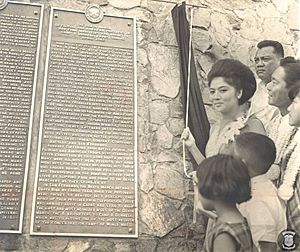
Ferdinand Marcos was elected as the 10th president of the Philippines on November 9, 1965. When he was sworn into office on December 30, 1965, Imelda officially became the First Lady.
The Romualdez family had been divided by the election campaign. To fix this, Imelda invited family members, even those who supported the other party, to their house in San Juan. Ferdinand and Imelda held a Mass at their house before going to Luneta Park for the inauguration. That night, a dinner was held for 60 guests at the Malacañang Palace.
Early Projects
In her first three years as First Lady, she spent money on improving Paco Park and Fort Santiago. In May 1966, Imelda started a plan to combine the efforts of many social welfare groups. This plan included building welfare villages and training staff for them. The first village, the Reception and Study Center in Quezon City, began construction in 1966. More centers were built until 1968, including Marilla Hills in Alabang and a Home for the Aged in Quezon City.
In mid-1967, Imelda started the "Share for Progress" Seed Dispersal Program. This project encouraged people to grow vegetables in empty lots across the country. By 1968, over 300,000 seed kits had been given out in more than 1500 towns.
Blue Ladies
The "Blue Ladies" were a group of wives of politicians in the Nacionalista Party. They played a key role in Marcos's 1965 campaign. They helped raise money and spread awareness. They visited factories and farms to meet voters and talked to people in slum areas. They also used radio and television to campaign for Marcos. These women were often wealthy and prominent.
As First Lady, Imelda often asked members of the Blue Ladies to travel with her. One of her famous socialite friends was Cristina Ford. Some of Imelda's Blue Ladies helped with her spending on fashion. In 1968, one of them, Maria Luisa, traveled with Imelda overseas. During this trip, Imelda and her daughter Imee spent a large sum of money.
Beatles Incident
On July 4, 1966, the First Lady invited the Beatles to perform at a private event. The band declined the invitation. Because of this, there was a misunderstanding that led to problems for the band when they tried to leave the country. There were reports that a large tax assessment was issued to their manager.
Gaining More Political Influence
Imelda began to develop her own political plans, which gave her more and more power. At first, this meant she had freedom with her projects while her husband prepared for the 1969 presidential campaign. As her husband's health declined, she was given more powerful roles. These included Minister of Human Settlements and Governor of Metro Manila.
Second Term (1969–1972)
In July 1974, the annual Ms. Universe pageant was held in Manila. First Lady Imelda Marcos reportedly spent a large amount of money to renovate public and private buildings in Manila and other cities where the pageant participants were toured.
Foreign Relations Roles
Since the President rarely left the Malacañang Palace, Ferdinand often sent his wife on official visits to other countries. She acted as a representative for him.
When the Marcoses visited the United States in September 1966, President Lyndon B. Johnson offered Imelda $28 million for war damage claims. President Johnson agreed that $3.5 million could be used for the Cultural Center, one of Imelda's projects.
For the opening of the Cultural Center of the Philippines (CCP), a special event took place on September 8, 1969. US President Richard Nixon was invited, but California Governor (and future President) Ronald Reagan and his wife attended instead. They flew to the country on Air Force One. There were stories that the First Lady tried to get other celebrities to ride Air Force One, but President Nixon did not allow it. This trip led to a close friendship between the Reagans and the Marcoses.
In 1971, Imelda attended Iran's 2,500-year celebration of the Persian Empire. This trip helped her meet some of the world's wealthiest people.
Constitutional Convention Accusations
On May 19, 1972, a delegate named Eduardo Quintero accused Imelda and others of trying to influence members of the Constitutional Convention. He claimed they were bribing members to vote against rules that would stop Marcos from staying in power beyond his allowed terms.
Actions Before Martial Law
Before May 1972, Ferdinand wrote in his diary that he and Imelda planned to risk everything for the country. On September 5, 1972, Imelda attended a party and spoke about democracy. On that same day, Martial Law was announced. Ferdinand said it was to create a "New Society" without problems like inequality or crime. Imelda called it "martial law with a smile."
Martial Law Period (1972–1981)
During this time, Imelda organized public events using government money to improve her and her husband's image. She brought the Miss Universe 1974 pageant to Manila, which required building the Folk Arts Theater in less than three months. She also organized the Kasaysayan ng Lahi, a festival about Philippine history. She started social programs like the Green Revolution, which encouraged people to grow food in their gardens to help with hunger. She also created a national family-planning program.
In 1972, she took charge of giving out a bread ration called Nutribun, which came from the United States Agency for International Development (USAID).
Stabbing Incident
On December 7, 1972, someone named Carlito Dimahilig tried to attack Imelda Marcos with a knife on live television. This happened at Nayong Pilipino. The attacker was shot by the police. Others were also hurt trying to stop him. The reason for the attack seemed to be her role in her husband's presidency.
Marcos was quickly taken by helicopter to the Makati Medical Center. Her husband drove to the hospital right away after hearing the news.
Foreign Relations Roles
In 1972, Imelda Marcos began many trips to the Soviet Union. These were called "cultural missions" but led to the Philippines and the Soviet Union becoming diplomatic partners.
In 1975, after King Faisal of Saudi Arabia passed away, Marcos wanted to offer official condolences. Women were not usually allowed in the Saudi court. However, Imelda, through a connection, became the first woman guest to be honored there.
In 1978, she was also appointed as an Ambassador. This allowed her to travel to the United States, the Soviet Union, Yugoslavia, and Cuba. During her travels, she became friends with leaders like Richard Nixon, Muammar Gaddafi, Saddam Hussein, Fidel Castro, and Josip Broz Tito. She traveled to Iraq to get oil and to Libya for a peace agreement.
Governor of Metro Manila
In 1975, Ferdinand Marcos created the Metro Manila Commission (MMC). This was the main government for Metro Manila. He appointed Imelda to lead it, making her Governor of Metro Manila. She held this position until the Marcos family was removed from power in 1986.
Minister of Human Settlements
Ferdinand Marcos appointed Imelda as the Minister of Human Settlements in 1976. She held this job until February 1986. This role allowed her to oversee the construction of many important buildings. These included the Cultural Center of the Philippines, the Philippine Heart Center, the Lung Center of the Philippines, and the Coconut Palace.
Batasang Pambansa
In 1978, the Kilusang Bagong Lipunan party put Imelda forward as a candidate. She ran in the Philippine parliamentary elections of 1978. Most of the opposing candidates were restricted due to Martial Law. Because of this, Imelda Marcos easily won a seat as a member of the Interim Batasang Pambansa (National Congress). She represented Region IV, which is Metro Manila.
Role in Benigno Aquino Jr.'s Travel
In 1980, former Senator Benigno Aquino Jr. had a serious heart problem. Imelda convinced her husband to let Aquino travel to the United States for medical care. This was arranged after Imelda secretly visited him in the hospital. Aquino reportedly agreed to return to the Philippines and not speak against the Marcos government in the US. After recovering quickly, Aquino decided to stay in the US.
Six months after martial law ended on January 17, 1981, Ferdinand Marcos was re-elected as president. As her husband's health declined, Imelda became very influential in his place.
Imelda stated that during her last meeting with Aquino in New York in May 1983, she asked him for hours to delay his return to the Philippines until it was safe. Aquino returned to the Philippines on August 21, 1983. He was assassinated at Manila International Airport upon his arrival. Ferdinand created a committee to investigate the assassination, which found the military responsible.
Downfall
On February 7, 1986, a special election was held between Ferdinand Marcos and Corazon Aquino. Corazon Aquino was the widow of Benigno Aquino Jr. Even though Ferdinand Marcos claimed to have won, there were accusations of cheating. This led to large protests, which became known as the People Power Revolution.
On February 25, Ferdinand Marcos and Imelda held their inauguration at Malacañang Palace. The couple later appeared on the Palace balcony in front of their supporters. Imelda sang a song for the crowd.
Later that day, Ferdinand Marcos agreed to step down. He and his family were given safe passage to leave the country for Hawaii, United States.
Exile in Hawaii (1986–1991)
At midnight on February 26, 1986, the Marcos family left the Philippines for Hawaii. About 80 people, including extended family and close friends, went with them. Their arrival caused controversy, and Hawaii residents soon asked the government to make the Marcoses leave.
The US Government first hosted them at Hickam Air Force Base. A month later, Ferdinand and Imelda moved into homes in Makiki Heights, Honolulu.
Ferdinand Marcos passed away in exile in September 1989. His son Bongbong was the only family member with him when he died.
After Imelda left Malacañang Palace, news reports worldwide noted her large collection of clothes. This included 15 mink coats, 508 gowns, 888 handbags, and 3,000 pairs of shoes. Some reports said there were up to 7,500 pairs, but Time magazine reported the final count was 1,060. The US government documented that the Marcos family entered the United States with millions of dollars in cash, stocks, jewelry, and gold bars.
Return from Exile (1991–Present)
On November 4, 1991, President Corazon Aquino allowed Imelda and her children to return to the Philippines. This was so they could face charges related to tax fraud and corruption. This was part of the government's effort to get money from the Marcos' Swiss bank accounts back to the Philippines.
After returning from exile, Imelda went back into politics. In 1992, Imelda ran for president in the 1992 Philippine presidential election. She finished 5th out of 7 candidates.
She was elected as a congresswoman for Leyte in the 1995 Philippine general election. She represented the first district, even though she faced a lawsuit. The Supreme Court ruled in her favor.
She chose not to run for re-election in Congress. Instead, she sought the presidency again in the 1998 Philippine presidential election. However, she later withdrew to support the winner, Joseph Estrada. She finished 9th among 11 candidates. She thought about running for mayor of Manila in the 2001 Philippine general election but did not.
In November 2006, Marcos started her own business, a fashion label called "Imelda Collection." It included jewelry, clothing, and shoes. Her daughter Imee helped her.
Imelda ran for the second district of Ilocos Norte in the 2010 Philippine House of Representatives elections. She replaced her son, Ferdinand Jr. (Bongbong), who ran for senator. During her term, she chaired the Millennium Development Goals committee in the Lower House.
She was re-elected on May 14, 2013, and again on May 9, 2016, for her third and final term.
In October 2018, Marcos filed to run for governor of Ilocos Norte in the 2019 Philippine general election. She was to replace her daughter, Imee, who could not run again and chose to run for senator. However, after being found guilty of misusing funds, she withdrew from the race a month later. Her grandson Matthew Manotoc took her place and later won the gubernatorial race.
Marcos had a successful heart procedure at St. Luke's Medical Center – Global City, Taguig on May 7, 2023. She was hospitalized in March 2024 for suspected pneumonia.
Major Court Cases
Imelda Marcos has been involved in many court cases in the Philippines and other countries. Some of these cases were about her misusing public funds. Others were about her bank accounts.
1988 Case in Manhattan
In October 1988, Ferdinand and Imelda Marcos, along with eight others, were accused of various crimes in Manhattan. These included misusing funds and trying to hide things. She said she was not guilty of using $103 million in government money to buy property and art in Manhattan. A wealthy heiress, Doris Duke, paid $5 million for her bail. In July 1990, after a three-month trial, she was found not guilty of all charges. She successfully presented herself as "a poor widow who knew nothing about her husband’s activities."
1990 Swiss Court Decision
In 1990, the Federal Supreme Court of Switzerland decided that money in the Marcoses' Swiss bank accounts came from illegal activities. This allowed about $356 million to be sent back to the Philippines. These funds had been frozen by Swiss courts in 1986 after the People Power Revolution. This decision later led to changes in 1998. These changes made it harder for leaders and criminals to keep their money in Swiss banks.
1995 Human Rights Case in Hawaii
In February 1995, a US court in Hawaii ruled against the Marcoses. It awarded $1.96 billion to 9,539 victims of human rights violations during the Marcos dictatorship. This decision was confirmed by a US appeals court in 1996. However, this ruling has not yet been fully carried out in the Philippines due to legal issues.
Cases in the Philippines
When the Marcos family returned to the Philippines in the early 1990s, 28 criminal cases were filed against Mrs. Marcos. These cases were about misusing public funds.
In 1993, Marcos was found guilty in one case. However, this decision was overturned by a higher court in 2008. The Philippine Supreme Court upheld this reversal in 2018 due to technical problems with the evidence.
In March 2008, a judge in Manila found her not guilty of 32 charges. These charges were about illegally moving funds to Swiss bank accounts between 1968 and 1976. The judge said the government did not prove its case.
In 2011, a court ordered her to return $280,000 in government funds. These funds were taken by her and her husband from the National Food Authority. On November 9, 2018, the court found Marcos guilty on seven counts of misusing public funds. This meant she could not hold any public office.
As of October 2015, Imelda Marcos still faced 10 criminal charges and 25 civil cases in the Philippines.
2018 Swiss Foundation Convictions
In 1991, Marcos was accused of ten corruption charges in the Philippines' anti-misuse of funds court. Twenty-seven years later, on November 9, 2018, she was found guilty on seven counts. These were for sending about $200 million to various Swiss foundations. This happened while she was governor of Metro Manila in the 1970s. The court also found her not guilty on three other counts. Since she did not appear in court, her earlier bail was taken away.
She was sentenced to prison terms ranging from six to eleven years for each count. This totaled a minimum of 42 years and 7 months, and a maximum of 77 years. The court also said Marcos could not hold any public office. This punishment would not start right away because she planned to appeal. She still withdrew her candidacy for governor.
On November 12, 2018, Marcos's lawyer asked the court for options after the conviction, including bail. The court allowed bail because of her "ill health." Marcos posted bail on November 16, 2018, a week after her conviction. She plans to appeal her conviction.
Personal Wealth
Court Rulings and Estimated Amount
The Philippine Supreme Court considers the large wealth of Ferdinand and Imelda Marcos to be "ill-gotten." This means it was gained improperly. This is based on a law from 1955. This law says that if a public official's property is "clearly too much compared to their salary and other legal income," it is likely to have been gained unlawfully. Most of the Marcoses' assets, including their jewelry, were considered unlawful in a 2012 decision. The court noted that Ferdinand Marcos's total salary as President was small, and Imelda Marcos's salary as Minister of Human Settlements was also small.
Estimates of this improperly gained wealth vary. Sources suggest it was about US$5 billion to US$10 billion in the last years of the Marcos government. The Daily Telegraph estimates her current declared net worth at $22 million. However, it states that she and her husband likely took billions of pesos while in power. The amount they took could have paid off all of the Philippines' foreign debt at the time.
In a 1985 report, the US Ambassador to the Philippines, Stephen Bosworth, estimated that the Marcoses had taken about US$10 billion "in recent years." This was during a time when the Philippine economy was rapidly declining. The same amount was mentioned by the Philippines' Office of the Solicitor General after Marcos was removed from power in 1986.
The first chairperson of the PCGG, Jovito Salonga, later estimated the amount to be between US$5 billion and US$10 billion. This was based on documents left by the Marcoses in 1986. This estimate has become widely known. Another economist, Dr. Jesus Estanislao, said this figure was for money taken out of the country just before the Marcos government fell. He said there was no way to know the exact amount of wealth gained since the 1950s, suggesting it could be as much as $30 billion.
Besides the Marcoses' large wealth, Imelda Marcos was known for spending it. Some people called her "the ultimate personification of conspicuous consumption." Once, Imelda spent $2,000 on chewing gum at the San Francisco International Airport. Another time, she made a plane turn around mid-air because she forgot to buy cheese in Rome. Part of her famous shoe collection is now in the National Museum of the Philippines. Another part is shown in a shoe museum in Marikina. Her old family home in Tacloban, which is also a museum, was damaged by Typhoon Haiyan (Yolanda). She still has homes in Ilocos Norte and Makati, where she lives.
Recovery of Funds
Some of this wealth has been recovered through court cases. It has either been returned to the Philippine government or given as payments to victims of human rights abuses during Marcos's presidency. Some money has also been recovered through agreements with Imelda or others who said the Marcoses had entrusted properties to them. Some recovery cases have been dismissed by courts due to issues with how they were filed or with evidence. An unknown amount of wealth is still to be recovered, as the full extent of the family's money is not known.
In March 1968, Ferdinand and Imelda opened four bank accounts in Switzerland using fake names. These accounts were later moved to other accounts under different foundations. But when the new Philippine government found records after the 1986 revolution, the Swiss government froze them. On December 21, 1990, the Swiss Federal Supreme Court ruled that these accounts could be given to the Philippine government. This was on the condition that a Philippine court also made a final decision. In 1997, the Swiss court confirmed the funds came from illegal activities. It allowed them to be moved to a special account in Manila. A Philippine Supreme Court ruling in 2003 allowed the money to be taken. Switzerland finally released a total of $683 million in Marcos funds to the Philippines in 2004.
Throughout the 1980s, Imelda Marcos bought four large buildings in Manhattan. These included the Crown Building and 40 Wall Street. She chose not to buy the Empire State Building because she thought it was "too showy."
On January 13, 2014, three collections of Imelda Marcos's jewelry were taken by the Philippine government. These were the Malacanang, Roumeliotes, and Hawaii collections. Paintings by Claude Monet were also seized. In 2015, a rare pink diamond worth $5 million was found in her jewelry collection. The three collections were valued at about $21 million on February 16, 2016. The government announced plans to sell them, but they had not been sold as of April 17, 2020.
Her property also included a 175-piece art collection. This included works by famous artists like Michelangelo and Raphael. On October 17, 2013, an attempt to sell two Claude Monet paintings led to a legal case in New York. The case was against Vilma Bautista, a former aide to Imelda Marcos. Bautista was sentenced in 2014 for trying to sell "valuable masterpieces that belonged to her country."
In total, about P170 billion of the Marcos wealth had been recovered by the PCGG by 2018. This is about $3.6 billion out of their estimated $5 billion to $10 billion of improperly gained wealth.
Net Worth in 2012
In 2012, Imelda Marcos stated her net worth was US$22 million. She was listed as the second-richest Filipino politician, after boxer and politician Manny Pacquiao. She has claimed, without proof, that her fortune came from Ferdinand Marcos finding Yamashita's gold. This is a legendary treasure believed by many in the Philippines to be Japanese loot from World War II.
Marcos has also said in interviews, "If you know how rich you are, you are not rich. But me, I am not aware of the extent of my wealth. That's how rich we are."
World Record for Largest Misuse of Government Funds
The amount the Marcoses were estimated to have taken from the Philippines is so large that it has been recognized in world records. Imelda Marcos, along with her husband Ferdinand, were jointly recognized in 1989 by Guinness World Records for the largest amount of money improperly taken from a government. This was an estimated 5 billion to 10 billion dollars. She is quoted as saying: "We practically own everything in the Philippines, from electricity, telecommunications, airlines, banking, beer and tobacco, newspaper publishing, television stations, shipping, oil and mining, hotels and beach resorts, down to coconut milling, small farms, real estate and insurance." In 2009, Imelda Marcos was listed by Newsweek as one of the "greediest people of all time." To this, Marcos replied: "I plead guilty. For me, greedy is giving. I was first lady for 20 years, you have to be greedy first to give to all. It is natural. The only things we keep in life are those we give away."
Edifice Complex
The term "edifice complex" has been used to describe Imelda Marcos. It refers to her love for building large public structures, often very quickly. Imelda's building projects often used a style called Brutalist architecture. This style uses strong, massive shapes to create a feeling of grandeur.
In 1966, Ferdinand Marcos created the Cultural Center of the Philippines. He appointed its board of directors. The board chose Imelda as their chairperson. This gave her the legal power to manage funds for the center.
The Cultural Center of the Philippines (CCP) Complex is seen as the main symbol of Imelda's edifice complex. It was designed by architect Leandro Locsin. It was built on reclaimed land along Roxas Boulevard in Manila. It covered about 21 hectares. Money was granted for its construction, and it also received funds from other sources. When finished, it cost 50 million Philippine pesos. This was a huge increase from the original budget. Although building material prices increased, the large rise in costs was questioned. Imelda called the CCP Complex the "sanctuary of the Filipino soul." It became the main place for government-supported cultural events.
Another building project linked to Imelda during her husband's first term was the San Juanico Bridge. This bridge connects the island of Samar to Imelda's home province, Leyte. While she did not start the project herself, the government promoted it as Ferdinand Marcos's gift to his wife. It was built with foreign loans of $22 million. When it was finished on July 2, 1973, which was Imelda's birthday, experts called it a "white elephant." This meant it was built too early because not enough cars used it to justify its high cost.
Cultural Influence
"Imeldific"
In the late 1980s, it was revealed that Imelda Marcos had "collected a huge amount of art, jewelry, property and – most famously – at least 1,000 pairs of shoes." This made her a well-known name. She was often compared to Marie Antoinette of France, but "with shoes."
This led to the creation of the word "Imeldific" in Philippine English. It describes "anything exaggeratedly showy or in bad taste," referring to clothes, buildings, or decorations. It also refers to people who act like Imelda Marcos, being very extravagant and not afraid to show it. It can also describe a lifestyle of "showy extravagance."
The word is also used in International English. Dictionary writer Anne Soukhanov explained its meaning as "showy extravagance." In popular international media, Jackie Dent of the Sydney Morning Herald said it simply "means to be ... well, like Imelda."
The word is often linked to Imelda Marcos. However, it was used by Carlos Lopez of People Magazine as early as April 1986. He said, "Well, at least Mrs. Marcos has made a significant contribution to our lexicon. To call something 'imeldific' describes it as a shameless and vulgar extravagance."
Fashion
Marcos influenced fashion in the Philippines. Her role as a supporter of the arts and fashion is still debated. For example, she actively promoted the terno, a traditional Filipino dress. This dress also became her signature style. She promoted it through projects like "Bagong Anyo" and exhibitions abroad, such as the Philippine display at the Expo '75 in Okinawa, Japan.
Imelda made an effort to appear as a supporter of the arts. This included those who specialized in Filipino high fashion, like Pitoy Moreno and Inno Sotto. In a section of the 2003 Ramona Diaz film about her, Imelda said she kept her expensive clothes because it "inspired the poor to dress better."
Portrayals in News and Art
In August 2019, writer/director Lauren Greenfield released her documentary film The Kingmaker. It premiered at several film festivals. It was the first documentary to debut at all four major festivals in the same year. The film shows Imelda Marcos's political career. It focuses on her family's efforts to improve their image and return to political power. This includes her plans for her son Bongbong to become Vice President of the Philippines. The film received high ratings from critics.
In the late 1990s, Imelda Marcos agreed to be the subject of a TV documentary for PBS. It was called Imelda by Ramona S. Diaz. Released in 2003, the film tells the story of her marriage to Ferdinand Marcos, her time during the dictatorship, her exile in Hawaii, and her return to the Philippines. The film won an award at the 2004 Sundance Film Festival. Imelda Marcos tried to stop the film from being shown in the Philippines for a short time. When the ban was lifted, the film was very popular.
The villain character "Madame" in the popular Filipino Comic Book series Trese looks like Marcos. She has similar hair, butterfly sleeves, and strong connections to powerful figures in the Trese world.
The second song on Mark Knopfler's 1996 album Golden Heart is a song about her. In 2010, British producer Fatboy Slim and musician David Byrne released a concept album about her life called Here Lies Love. This later became a rock musical of the same name.
In Manila, performance artist Carlos Celdran was known for his "Living La Vida Imelda" walking tour. Filipino-American drag artist Manila Luzon pretended to be Mrs. Marcos in a challenge on RuPaul's Drag Race. She used humor about the First Lady's famous love for shoes. Hawaiian comedian Frank De Lima has also impersonated her.
She was portrayed by Nora Dunn on Saturday Night Live in 1988. She was also played by Clavel Bendaña in the 2003 film Chavit (film).
Actress Dimples Romana played Marcos in an episode of Maalaala Mo Kaya in 2010. Actress Ruffa Gutierrez also played her in the 2022 film Maid in Malacañang and its 2023 sequel, Martyr or Murderer. Cindy Miranda played the young Marcos in the latter film.
She is often mentioned in Netflix shows like Russian Doll, The Crown, and Dynasty.
An original musical, Here Lies Love, by David Byrne and Fatboy Slim, covers her life from childhood to exile. It uses disco and club music and special staging. The title refers to a phrase Imelda said she wanted on her tombstone. The musical started on Broadway on June 17, 2023, and closed on November 26, 2023.
Honors
 Japan: Grand Cordon (Paulownia) of the Order of the Precious Crown
Japan: Grand Cordon (Paulownia) of the Order of the Precious Crown
See also
 In Spanish: Imelda Marcos para niños
In Spanish: Imelda Marcos para niños


